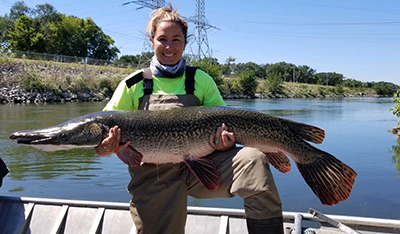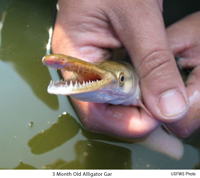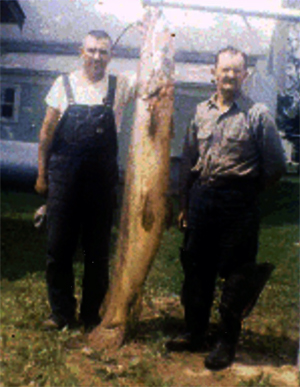Alligator Gar Reintroduction Program
IDNR Fish Species Management Plan for Alligator Gar (Atractosteus spatula) in Illinois
(Download PDF)
Alligator Gar (Atractosteus spatula) populations have been declining within their historic range for at least the past 50 years and are considered to be extirpated from much of the northern reaches (Nature Serve, 2015). Declines have been attributed to several factors, most notably over-exploitation and loss of important backwater spawning habitats from the construction of levees and lock-and-dams beginning in the early 1900s. While no single factor can be identified as the definitive cause for the decline, it is likely that a combination of these factors over time resulted in the extirpation of the Alligator Gar from Illinois.
The Alligator Gar was not regulated or protected in Illinois prior to 1977. From 1977 to 1994, the species was listed as a state-threatened fish under the Illinois Threatened and Endangered Species Act. In 1994, the Alligator Gar was delisted and considered to be extirpated.
This plan proposes efforts and activities necessary to successfully re-establish and extensively manage Alligator Gar populations in Illinois. The success of the plan will be documented through annual progress and achievement reports for each management objective. The plan is considered to be an evolving document and will be used as an adaptive management tool by Illinois Department of Natural Resources, Division of Fisheries.
Download the PDF here that describes the management plan in detail for Alligator Gar.
Return of the Dinosaurs
 Alligator Gar is the largest fish native to Illinois. With records dating back to prehistoric years, this species had not been seen in the state since the last documented Alligator Gar catch in the Cache River cutoff channel in southern Illinois in 1966. Alligator Gar were officially declared extinct in Illinois in the 1990s.
Alligator Gar is the largest fish native to Illinois. With records dating back to prehistoric years, this species had not been seen in the state since the last documented Alligator Gar catch in the Cache River cutoff channel in southern Illinois in 1966. Alligator Gar were officially declared extinct in Illinois in the 1990s.
In 2010, the IDNR's Division of Fisheries began an Alligator Gar reintroduction program in coordination with the USFWS. During that time, Alligator Gar were stocked in a few waterways, including the lower Kaskaskia River.
The reasons for reintroducing the Alligator Gar are twofold: Bringing back an extirpated species to Illinois waters is one of the goals. In addition, the Alligator Gar is becoming a popular trophy quarry for sportsmen in the southern part of their range, Louisiana and Texas. Bowfishing enthusiasts and catch-and-release anglers are excited for this potential in Illinois waters.
A statewide administrative rule for Alligator Gar was finally initiated in Illinois on 4/1/2019. The harvest regulation allows the creel of one Alligator Gar per 24-hour period, and no commercial harvest is allowed. Anglers are encouraged to report any Alligator Gar harvest or catches with a picture to the IDNR. An informational page is included in the annual regulation book andon this website. Requested information will help biologists to collect data from anglers and bow fishers regarding fishing pressure and harvest.
For those worried that Alligator Gar would be detrimental to popular sportfish species, biologists say the Alligator Gar is an opportunistic predator that mostly targets shad and rough fish, such as carp. However, IDNR biologists warn that controlling Asian Carp is not the reason for this reintroduction. Although Alligator Gar are an apex predator that will take Asian Carp, nothing can control the their population right now. In the long-term, creating commercial markets for Asian Carp will be the best hope of reducing their numbers.
To answer another note of concern to some, there is no documented evidence suggesting that Alligator Gar will bite a swimmer. That has been a concern posed to the Division of Fisheries anbd the simple answer is thatswimmers simply don’t look like a prey species to an Alligator Gar.
 Alligator Gar stocking has coccured in the southern 2/3 of llinois waters, which have the correct habitat for this species and is therefore conducive to their survival. They are being stocked initially in very small numbers in certain places to see if they can be established. Our neighboring states, Kentucky and Missouri, are also taking part in this reintroduction program with the small fish (fry) initially coming from the US Fish and Wildlife Service hatchery, then raised in the state hatcheries to stocking size.
Alligator Gar stocking has coccured in the southern 2/3 of llinois waters, which have the correct habitat for this species and is therefore conducive to their survival. They are being stocked initially in very small numbers in certain places to see if they can be established. Our neighboring states, Kentucky and Missouri, are also taking part in this reintroduction program with the small fish (fry) initially coming from the US Fish and Wildlife Service hatchery, then raised in the state hatcheries to stocking size.
Currently there are four types of Gar found in Illinois: Spotted, Shortnose, Longnose and now the Alligator. Alligator Gar were not traditionally found in large numbers in Illinois, and though they do grow quickly, it awaits to be seen this program’s success as females mature and reproduce in 11+ years. We will monitor this program closely and will implement creel and size limits if necessary as this population becomes established.
To effectively manage these prehistoric fish, the IDNR is working closely with University of Illinois researchers to study how Alligator Gar, in addition to the three other Gar species, grow, mature, reproduce and migrate to make certain these species continue to troll Illinois' waterways.
Fun Fact:
Alligator Gar can grow very quickly early in life, meaning that the stocked Gar will quickly become accessible to anglers. In August 2022, two Alligator Gar were collected by IDNR Fisheries biologists from the intake canal at Powerton Lake. Both of these fish were 13 years old, and they were stocked and PIT tagged as 2-year-old fish in June 2011 into Powerton Lake. When they were collected in August of 2022, they had an average length of 57.7 inches and 42.2 pounds each!

Historical Perspective
This historic photo is reported to be the last alligator gar captured in Illinois. The fish was caught on hook and line from the Cache-Mississippi Diversion Channel in Alexander County in 1966. It was approximately seven feet in length and weighed in at around 130 pounds!
Additional Fun Facts:
- Alligator Gar can exceed 300 pounds and reach 10 feet in length, making them the largest fish in the Mississippi River Valley, including Illinois.
- Alligator Gar are long lived, with some captured individuals estimated to be nearly 100 years old.
- Alligator Gar eggs are reported to be toxic to some animals, presumably as a defense mechanism.
Source: Poly, W.J. 2001. Distribution of the alligator gar, Atractosteus spatula (Lacepede, 1803), in Illinois. Transactions of the Illinois Academy of Science 94(3): 185-190.
Photo: courtesy of Brooks Burr



